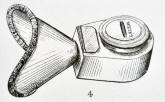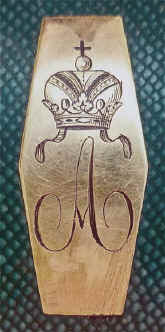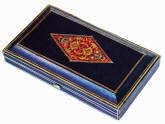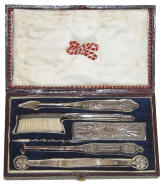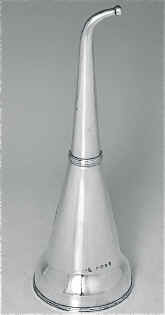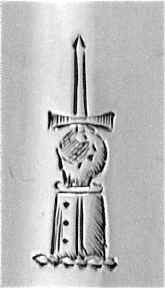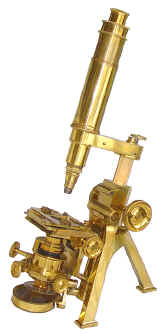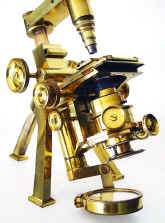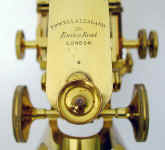9. A c. 1815 antique chiropody instrument set made by the famous coutelier Pierre-François Grangeret, Paris, for the Emperor Alexander I of Russia (1777-1825). The two scissors are interesting: one is marked A DROITE [right] and the other A GAUCHE [left]; while the inside of the blades show the name GRANGERET and the Grangeret hallmark H surmounted by a crown. Grangeret is France's finest surgical instrument maker of the early 19th century. The lid of the shagreen-covered case is set with a solid gold plaque upon which is artfully engraved Tsar Alexander I's cipher monogram of a uniquely styled letter A topped by the Great Imperial Crown of Russia. Surviving Grangeret records and trade labels catalogue sales to Napoleon I, Louis XVIII, Charles X, and Tsar Alexander I. Several medical instruments of Peter the Great exist but no other tsar's instruments are noted. $6,500
10. An attractive and high quality c. 1820s French antique dental hygiene set in leather case with inner lid mirror and protective pad. From top to bottom the contents are a spearpoint scaler; a toothbrush; a dentifrice box; a double-ended toothpick; a triangular scaler; and a tongue scraper. All handles and three entire pieces are silver. The tongue scraper and toothpick have flat areas that will take hallmarks. Both have the Paris rabbit head silver guaranty mark of 1819-1838. The silver standard and silversmith punches have yet to be deciphered. Palmetts are the central decorative motif. $3,500
The exact antique anesthesia inhaler presented is subsequently illustrated with the check valve system in Murphy's 1855 publication on chloroform inhalation, p. 30. Murphy gives no maker or specific name to this revised inhaler. (The venture Stevens & Pratt appears to have been dissolved by the early 1850s.) Note also the addition of a padded edge to the mouthpiece in the drawing, another feature not seen in the 1847 inhaler. Furthermore, the upgraded inhaler is illustrated in the Weiss catalogue of 1863, now identified as Murphy's Inhaler. See Weiss, 1863, pl. XLI, fig. 4. The Murphy's inhaler underwent many modifications over the next 50 years. First generation chloroform inhalers, such as this example which is thought to be the earliest recorded surviving example of a Murphy's inhaler, are exceedingly scarce instruments from the history of anesthesiology.
The Gower Street area is a fecund neighborhood for the beginnings of anesthesia. Besides the home of Stevens & Pratt, surgical instrument maker, and the University College Hospital where John Liston performed the first surgery in Europe under anesthesia, residents included Francis Boott, John Robinson, John Snow, and, to expand the field a bit, Charles Darwin.
The illustrations correlate to the order of the citations.
This Murphy's inhaler is the oldest example known to this dealer covering over 40 years experience with selling medical antiques. $17,500


